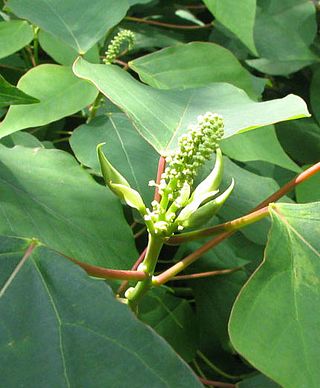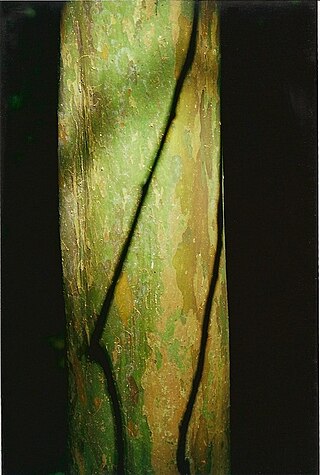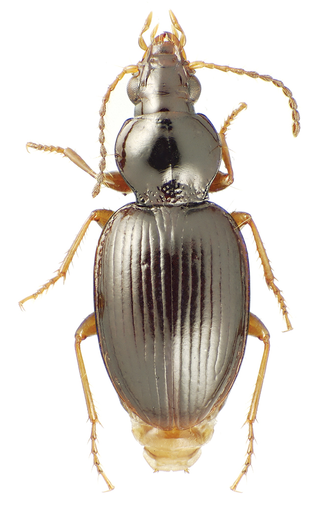
The Papua New Guinea national soccer team is the men's national soccer team of Papua New Guinea and is controlled by the Papua New Guinea Football Association. Its nickname is the Kapuls, which is Tok Pisin for Cuscus.

Homalanthus is a genus of plants in the family Euphorbiaceae, first described in 1824. It is the only genus in the subtribe Carumbiinae. It is native to mainland Southeast Asia, Malesia, Papuasia, northern and eastern Australia, and various islands in the Pacific.

Lamiinae, commonly called flat-faced longhorns, are a subfamily of the longhorn beetle family (Cerambycidae). The subfamily includes over 750 genera, rivaled in diversity within the family only by the subfamily Cerambycinae.
Hunga is a genus of plants in the family Chrysobalanaceae described by British botanist Ghillean Prance in 1979. Species in this genus are native to New Guinea and New Caledonia.

The New Caledonia cricket team is the team that represents the French overseas territory of New Caledonia in international cricket matches. They are not currently a member of the International Cricket Council, though they have taken part in various regional tournaments such as the Pacifica Cup and the cricket tournaments of the South Pacific Games.

Parsonsia is a genus of woody vines in the family Apocynaceae. Species occur throughout Indomalaya, Australasia and Melanesia.

Gossia is a genus of rainforest trees in the myrtle family first described as a genus in 2003. It is native to northeastern Australia as well as several islands of Papuasia and New Caledonia.

Mecyclothorax is a genus of beetles that contains over 400 described species or subspecies, mostly from the Hawaiian Islands, and Tahiti and Moorea, French Polynesia. Additional radiations have evolved in Queensland, Australia, New Guinea and New Caledonia. The genus has been divided into five subgenera: Eucyclothorax Liebherr 2018 of Australia, Qecyclothorax Liebherr 2018 of Queensland, Australia, Meonochilus Liebherr & Marris, 2009 of New Zealand, Phacothorax Jeannel 1944 of New Caledonia, and the more widely distributed subgenus Mecyclothorax Sharp 1903 [in Australia, the Sundas, New Zealand, the Society Islands, and Hawaii]. The adelphotaxon to Mecyclothorax is hypothesized to consist of the genera associated with Amblytelus Blackburn, also distributed in Australia, and therefore the evolutionary history of Mecyclothorax commenced in Australia.

Desmiphorini is a tribe of longhorn beetles of the subfamily Lamiinae.

Bacchisa is a genus of longhorn beetles of the subfamily Lamiinae.
Gressittana is a genus of leaf beetles in the subfamily Eumolpinae. It contains only one species, Gressittana sculpturata, which was originally placed in Rhyparida. The genus is endemic to New Guinea, and is named after Judson Linsley Gressitt.

Typophorini is a tribe of leaf beetles in the subfamily Eumolpinae. The tribe contains approximately 100 genera, which are found worldwide. Members of the tribe are mainly characterized by notches on the tibiae of the middle and hind legs, which are sometimes referred to as antenna cleaners. They also generally have a subglabrous body, as well as bifid pretarsal claws.
Phainodina is a genus of leaf beetles in the subfamily Eumolpinae. It is distributed in New Guinea, and its name refers to the beetles being shiny and Nodina-shaped.
Iviva is a genus of leaf beetles in the subfamily Eumolpinae. It is distributed in New Guinea, and it is named after the type locality of the type species, Lake Iviva (Sirunki), in the Western Highlands province of Papua New Guinea.
Micromolpus is a genus of leaf beetles in the subfamily Eumolpinae. It is distributed in New Guinea, and its name refers to "a small eumolpine beetle".
Rhynchomolpus is a genus of leaf beetles in the subfamily Eumolpinae. It is distributed in New Guinea, and the name refers to its resemblance to a snout beetle.
Stethotes is a genus of leaf beetles in the subfamily Eumolpinae. It is distributed in Southeast Asia and the Western Pacific.

Thoris is a genus of longhorned beetles in the family Cerambycidae. There are about eight described species in Thoris.
Epania is a genus of longhorn beetles in the family Cerambycidae. There are more than 60 described species in Epania, found mainly in Southeast Asia, but also in southern and eastern Asia, and Australia.











